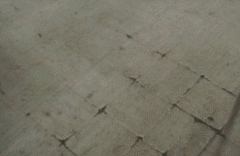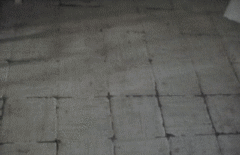
|
Lorna Mills and Sally McKay
Digital Media Tree this blog's archive OVVLvverk Lorna Mills: Artworks / Persona Volare / contact Sally McKay: GIFS / cv and contact |
View current page
...more recent posts
email from Joe McKay:
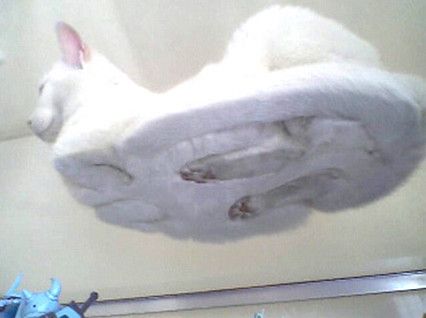
A few more notes on Adaptation at the Power Plant. Overall I liked the show (despite installation problems). Power Plant always does something big and broad and free in the summer, and animal/human interaction is not a bad theme for a blockbuster. I talked about Cory Arcangel's video the other day (fractious thread). I'd like to just mention a couple of other artworks that I really liked.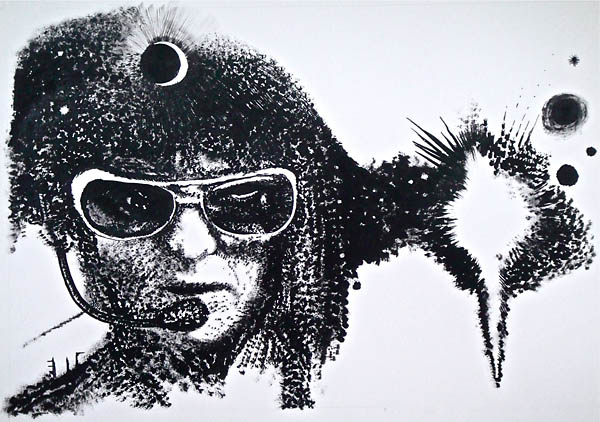 FASTWURMS, Cat vs Dragon, 'meow',, 2010. ink on paper FASTWURMS based their installation on one of the best sci-fi short stories ever, "The Game of Rat and Dragon" by Cordwainer Smith. In the story, military human astronauts pair up with cats into telepathic teams that patrol the territory in outerspace to keep out "dragons." Each of the cats and humans have their own personalities, and some jive better than others. Our protagonist is kind of in love with one of the cats, and when they work together they make a killer team. FASTWURMS did fantastic black and white illustrations for the story and mounted them on the wall with the full text. In the age of ubiquitous cat imagery, FASTWURMS' cat art stands out because the cats aren't presented as ciphers for projections of human desire, but as powerful personalities in their own right . As witches, they take interspecies communication very seriously. But taking something seriously doesn't mean you can't have fun and kid around! Never cynical, but almost always ironic, these two know how to play with pop culture and sci-fi tropes to make strong assertions about the ways that humans and animals are entangled together with forces of nature/culture. The premise requires a suspension of disbelief on the part of the audiences, but FASTWURMS' love of kitsch makes that process easy. 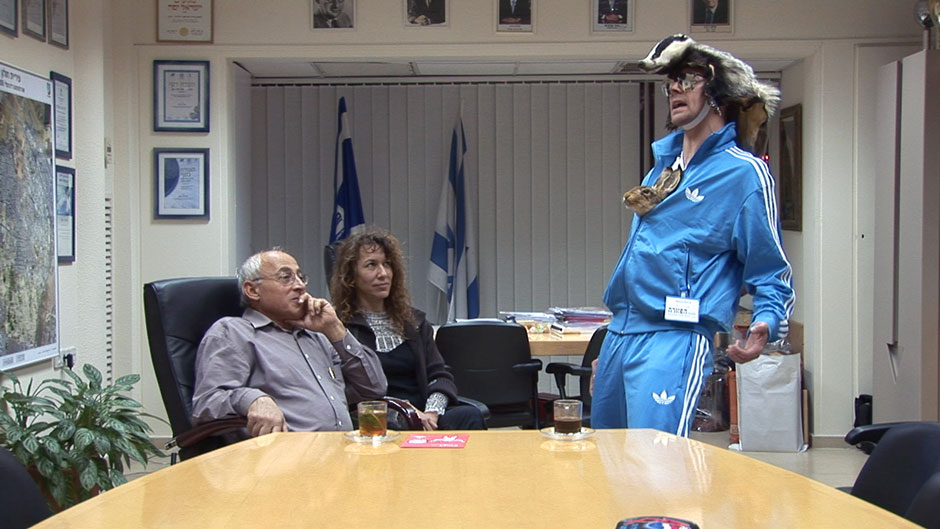 video still from Marcus Coates' The Plover's Wing, A meeting with the mayor of Holon, Israel The British artist Marcus Coates also demands a suspension of disbelief as he channels animal spirits. In contrast to FASTWURMS, he really ramps up the uncomfortable tension between spoof and sincerity, making the suspension of disbelief a much more difficult decision. The video that impressed me the most was The Plover's Wing, A meeting with the mayor of Holon, Israel. Coates, wearing a dead badger on his head with a dead rabbit head poking out of the zipper on his track jacket, meets with the mayor of Holon. Through an interpreter, Coates offers his services as an animal spirit medium, and invites the mayor to ask him a question that has been bothering him. The mayor says he has a problem with youth violence in the city and he wants to figure out how to solve it as a means of working toward a less violent future in the Israel/Palestine conflict. Coates asks the mayor to move his chair back a little, and then goes into a long, loud trance, shaking and whooping, crouching and chirping and croaking. Playing the fool in some ways, he is also very convincing, demonstrating a performative depth of commitment to the exercise. He comes out of his trance eventually (to the apparent relief of the mayor and the interpreter, who is trying hard to keep a straight face), and calmly gives a quite cogent interpretation of his journey into the animal world. The mayor listens politely, and at the end offers feedback to the effect that he thinks Coates is sincere and not just playacting. I think so too. The video reminded me of Kristin Lucas performances where the artist inhabits a space that is difficult to accept. In the case of both Coates and Lucas, the work is much richer if the viewer can accept the terms as stated, and allow themselves into a suspension of disbelief, playing along with the artists' own commitment to the scenarios they present. Coates may be nuts, but I don't think he's scamming. And if he is, who cares? The concept is great, and better if you buy into it, at least for the duration of the performance. Both Coates and FASTWURMS push the limits of what audiences might normally accept as interspecies communication, tempting incredulity and teasing the realm of the supernatural. But both are also firmly rooted in the artworld, where paradoxical meanings have long been accepted. It's not necessary to make a definitive declaration that Coates is really channelling animal spirits, or thatFastwürms really communicate telepathically with cats. It's enough to respect the sincerity with which the artists propose the premise, and, at least temporarily, engage with the work on those terms. And interspecies communication is something well worth exploring these days, when social networks are fetishized as anonymous abstract structures in and of themselves, human brains are likened to computers rather than organisms, and climate change and species extinctions are sad and urgent facts of life. |
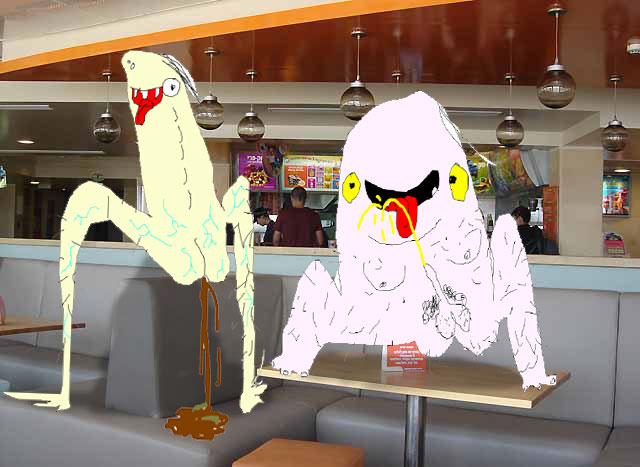
welcometomacdonalds.jpg from cockweasle
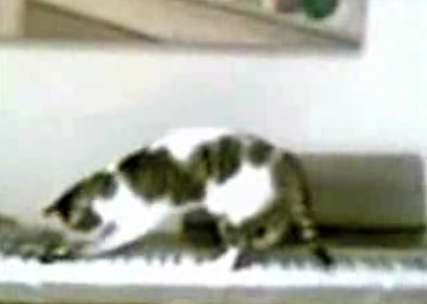 Still from Cory Arcangel's video Schoenberg’s Cats Last year we criticized Cory Arcangel and Hanne Mugaas’ Art Since 1950 performance pretty heavily on this blog. And there's been some convincing criticism of his video Schoenberg’s Cats at ArtFagCity. So when I went down to Power Plant to see the group show Adaptation I was fully prepared not to like the piece. But it turned out I liked it a lot, for several reasons. First of all, youtube looks fantastic in a gallery. The video was displayed on a not-too-fancy monitor (no high-def plasma screen, just a biggish, oldish monitor on a video cart...very simple) but still much larger than the youtube window online. The pixelated low rez look of youtube, thus translated, is really dramatic. In the context of a high-end gallery where all the other video works had high-end production values, the explosion of blurry pixels and inconsistent quality reads like an intentional aesthetic decision. And it's a good one, very pretty and engaging if you happen to have a taste for the various ways that video can look on screens. There is a lot of ongoing discussion about the failure of curators to deploy social media in the gallery or museum. And I agree that the two contexts don't mash well at all. This was my problem with Art Since 1950... there is nothing more irritating than watching someone else click links. If Arcangel's cat video was not a discrete, edited piece but a curated collection of found cat & piano footage from youtube it would be a real drag. Youtube as-a-resource is better online. The joy of youtube is that there is very little imposed structure and its a participatory community where viewers are creators...etc, etc. Those kinds of modes of engagement just don't translate into a gallery. Sure you could set up a monitor connected to the internet and people could sit and surf through collections online, but why would you? It's much, much more sensible to look at art that way at home. But the Schoenberg cat video, as displayed in the exhibition, is not an example of online art. It's an example of gallery art in the age of youtube, and the aesthetic is instantly recognizeable. Power Plant in summer gets a lot of tourist traffic. It's down by the lake at Harbourfront where people go to eat ice cream, watch buskers, listen to music, take boat tours and buy souvenirs. Many of them wander into the gallery because its free and well marked - big signs and arrows outside the building that say ART, FREE, ENTRANCE, and such like. When I first walked into the space there were two little girls running up to Arcangel's video with their arms outstretched, chirping "Kitties! Kitties!" and then tickling and scrunching their fingers at the screen while various cats flopped around on various pianos. These kids weren't thinking, "My what terrible video quality" they were responding to a medium they recognized with a sense that it belonged to them and they were welcome to interact. I'm a fan of cat and piano videos. I often plop in those search terms to see if there's anything new I've missed. Arcangel's edit is very sweet, and the musical structure is perfect for an installation. It's atonal enough to be believable, cats padding on keyboards creating those very chords, and yet it's melodic enough to give a shape to the piece. The Schoenberg number imposes a narrative structure: beginning, middle and end. And that's necessary when the audience is not online, and free to click away. But at the same time the youtube aesthetic is clear, and curated in together with full-on wall-sized projected video and wall-mounted plasma screens it reads like the people's medium. There are some purists who think that when artists who work online show pieces in a gallery they are selling out the participatory ethics of online interaction. But at the same time, there is grumbling that curators and gallery audiences need to figure out how to address the internet. There are plenty of artists who work in both contexts, and showing sensitivity to the differing audience needs between online and gallery interaction is a genuine skill. I don't like Schoenberg’s Cats online. I'd rather just watch youtube cats that I select myself. But in the Power Plant's white cube, a surprisingly social space on a sunny August afternoon, I enjoyed it very much indeed. |
